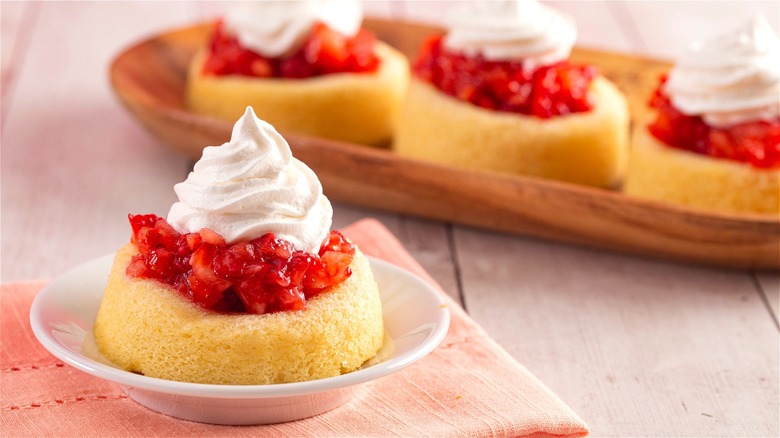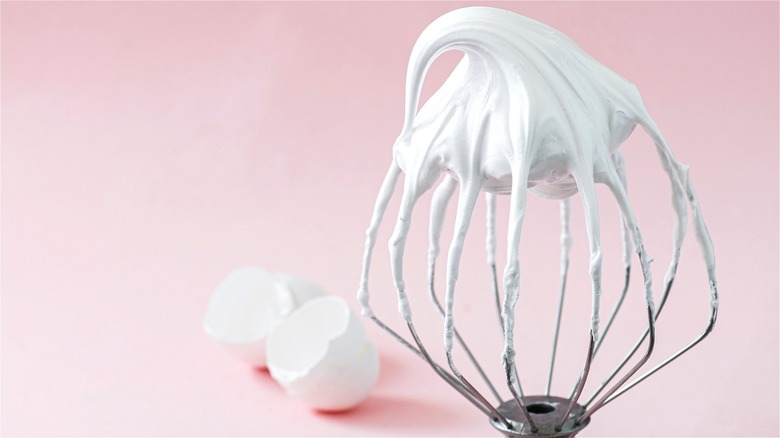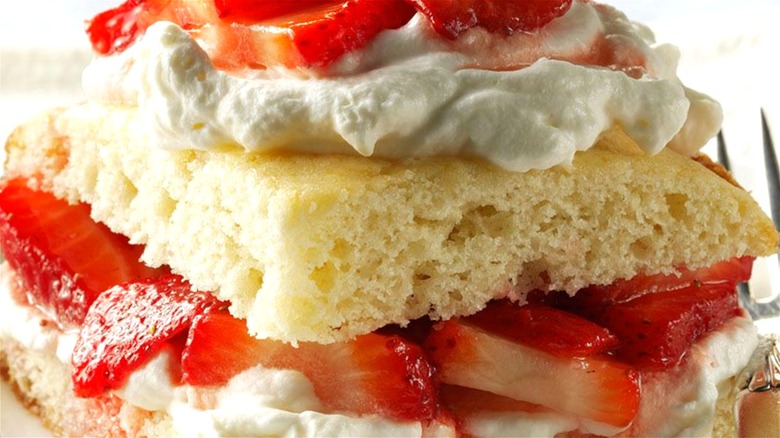The Egg-Beating Tip That's Crucial For A Perfect Strawberry Shortcake
Who doesn't love sitting down to a homemade plate of fresh strawberry shortcake amidst the height of the summer season? As long as you have a neutral cake or biscuit base, ripe strawberries, and sweetened whipped cream, you're just a few small steps away from hand-crafting a specialized version of this seasonal delight. For foodies who've given up crumb-heavy shortcakes for the lush consistency of homemade sponge cake and its incredible ability to soak up that precious strawberry juice, you may want to pay extra attention to how you incorporate raw eggs into the cake batter. Make sure you're beating those precious eggs for just the right amount of time to achieve a perfectly light, airy texture.
Sponge cake's soft and springy texture is often achieved through the process of whipping raw, separated eggs to increase the amount of air mixed into the batter. In this instance, eggs not only work to add a certain richness to sponge cake, but they also serve as a necessary leavening agent.
How long should you beat eggs when making homemade sponge cake?
The three main components that make up a classic sponge cake are eggs, flour, and sugar. Of those, eggs might be the most crucial ingredient. How they're mixed can make or break the structure of a sponge cake. Because there are so many recipes out there for foam cakes, if your favorite recipe has you separating the whites from the yolks, you'll want to be extra strategic when it comes to those precious egg whites.
Pastry and baking arts expert at the Institute of Culinary Education Penny Stankiewicz told The Kitchn that eggs should be mixed until medium peaks form. Eggs that haven't been mixed to maximum stiffness will better develop during the instructed cooking time.
And if you're wondering what the difference is between the varying levels of egg white formation, medium-peaked egg whites will stick to the beaters of a mixer easily but will also showcase gentle ridges or loops when touched. Stiff peaks, on the other hand, are whipped egg whites that stand high when a mixer is removed without bending or losing shape.
When eggs are the central ingredient in baked goods, handle them with care
Now that you know medium peaks are the way to go for soft, springy sponge cake, let's review some of the other important factors to keep in mind with this delectable treat. If you're making sponge cake to craft a homemade strawberry shortcake, how you whip the eggs isn't the only component worth remembering.
Ideally, you'll want to start the process with room-temperature eggs, so make sure you set them on the counter for roughly 30 minutes before whipping. Whip the eggs in a clean bowl with no bits of egg yolk or residual oil from your last cooking ventures, as those minor extras can impact the egg whites' development. Beyond whipping the egg whites until medium peaks form, how you combine the additional ingredients into the cake batter matters more than you might guess. To maintain their structural integrity, add the whipped egg whites gently so you don't risk losing the precious air you added during the mixing process.
If you're worried about maintaining the egg whites' form, add a small amount of cream of tartar to the raw egg whites before whipping them. Cream of tartar works to balance the consistency of aerated egg whites so that they maintain their structured shape. Taking extra care of those precious eggs will not only make for a lighter, chewier sponge cake, but you'll also have an ideal base to make a sweet, juicy platter of strawberry shortcake.


